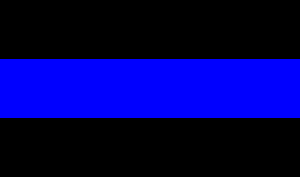Thin blue line: Difference between revisions
No edit summary Tags: Visual edit Mobile edit Mobile web edit |
No edit summary Tags: Visual edit Mobile edit Mobile web edit |
||
| Line 16: | Line 16: | ||
*'''The Thin Silver Line''' – [[Corrections officer]]s{{Citation needed|date=July 2016}} |
*'''The Thin Silver Line''' – [[Corrections officer]]s{{Citation needed|date=July 2016}} |
||
*'''The Thin Yellow Line''' – Tow Truck Drivers, The Old Line for Loss Prevention Officers, Security Officers (Now adopted the Thin Green Line){{Citation needed|date=July 2016}} |
*'''The Thin Yellow Line''' – Tow Truck Drivers, The Old Line for Loss Prevention Officers, Security Officers (Now adopted the Thin Green Line){{Citation needed|date=July 2016}} |
||
*'''The Thin Green Line''' - [[Security]] officers |
*'''The Thin Green Line''' - [[Security guard|Security]] officers |
||
*'''The Thin Gold Line''' – [[Dispatcher]]{{Citation needed|date=July 2016}} |
*'''The Thin Gold Line''' – [[Dispatcher]]{{Citation needed|date=July 2016}} |
||
*''' The Thin White Line''' – [[Emergency medical services]].{{Citation needed|date=July 2016}} The thin white line differs from other thin lines in that the background is blue instead of black, with a white line crossing horizontally through the middle. [[Emergency medical services|EMS]] also still uses the "Thin Orange Line" which is primarily used by [[Search and Rescue]].{{Citation needed|date=July 2016}} |
*''' The Thin White Line''' – [[Emergency medical services]].{{Citation needed|date=July 2016}} The thin white line differs from other thin lines in that the background is blue instead of black, with a white line crossing horizontally through the middle. [[Emergency medical services|EMS]] also still uses the "Thin Orange Line" which is primarily used by [[Search and Rescue]].{{Citation needed|date=July 2016}} |
||
Revision as of 15:27, 19 September 2016
This article may be confusing or unclear to readers. (July 2013) |


The Thin Blue Line is a symbol used by law enforcement, originating in the United Kingdom but now prevalent in the United States and Canada to commemorate fallen law enforcement officers and to symbolize the relationship of law enforcement in the community as the protectors of fellow civilians from criminal elements. It is an analogy to the term Thin Red Line.
Each stripe on the emblem represents certain respective figures: the blue centre line represents law enforcement, the top black stripe represents the public whilst the bottom represents the criminals. The idea behind the graphic is that law enforcement (the blue line) is what stands between the violence and victimization by criminals of the would-be victims of crime.[1]
Proponents of the symbol assert that the identifier is intended to show support for police.[1] In the wake of controversies over police shootings, the Thin Blue Line Flag has become popular among law enforcement personnel, their families and supporters.
Variations

After the popularity of The Thin Blue Line emblem for law enforcement came a number of other "thin lines".
- The Thin Orange Line – Search and Rescue Personnel, sometimes used by civilians possessing a concealed carry weapon permit[citation needed]
- The Thin Red Line firefighters[2]
- The Thin Grey Line Fugitive Recovery Agents, Bail Bonds Officers, Bounty Hunters[citation needed]
- The Thin Silver Line – Corrections officers[citation needed]
- The Thin Yellow Line – Tow Truck Drivers, The Old Line for Loss Prevention Officers, Security Officers (Now adopted the Thin Green Line)[citation needed]
- The Thin Green Line - Security officers
- The Thin Gold Line – Dispatcher[citation needed]
- The Thin White Line – Emergency medical services.[citation needed] The thin white line differs from other thin lines in that the background is blue instead of black, with a white line crossing horizontally through the middle. EMS also still uses the "Thin Orange Line" which is primarily used by Search and Rescue.[citation needed]
- The Thin Black Line – Nurses.[citation needed] The thin black line differs from other thin lines because it is a white background with a horizontal black line through the middle.[citation needed]
History
The term came into broad use after the release of Errol Morris' 1988 documentary film The Thin Blue Line, about the murder of a Dallas Police officer Robert W Wood. Judge Don Metcalfe who presided over the trial of Randall Adams, states in the film, that prosecutor "Doug Mulder's final argument was one I'd never heard before: about the "thin blue line" of police that separate the public from anarchy." The judge admitted to being deeply moved by the prosecutor's words, though the trial resulted in a wrongful conviction and death sentence.[3]
References
- ^ a b "The Thin Blue Line". kubby.com. 19 September 1999. Retrieved 16 June 2014.
- ^ http://www.ncfff.org/memorial/red-line-of-courage/
- ^ http://www.errolmorris.com/film/tbl_transcript.html
